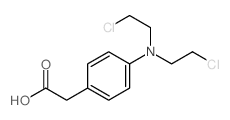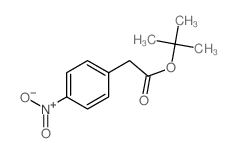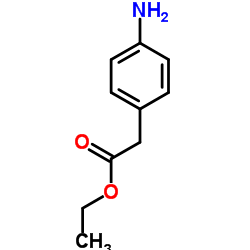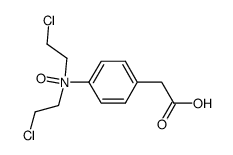10477-72-2
| Name | 2-[4-[bis(2-chloroethyl)amino]phenyl]acetic acid |
|---|---|
| Synonyms |
PAAM
Chlorphenacyl Phenylacetic acid mustard Khlorfenatsil Chlorphenacil Phenacid Phenylacetic mustard |
| Description | Phenylacetic acid mustard is the major metabolite of the cancer chemotherapeutic agent Chlorambucil (HY-13593). Chlorambucil is an alkylating agent with antitumor activity[1]. |
|---|---|
| Related Catalog | |
| Target |
IC50: metabolite of Chlorambucil[1] |
| In Vivo | Phenylacetic acid mustard (intraperitoneal injection; 0-20 mg/kg; 15 days) shows consistently 1.8-1.9 times greater antitumour potency thanCHL, it exhibits an ED15 value of 8.0 mg/kg[2]. Phenylacetic acid mustard (intraperitoneal injection; 0-20 mg/kg; single dose) cause 50% lethality at the dose 15.9 mg/kg[2]. Animal Model: Inbred male C3H/He mice[1] Dosage: 0 mg/kg; 5 mg/kg; 10 mg/kg; 20 mg/kg Administration: Intraperitoneal injection; 15 days Result: Exhibited anti-tumor activities in vivo. |
| References |
| Boiling Point | 195.5ºC at 760 mmHg |
|---|---|
| Molecular Formula | C12H15Cl2NO2 |
| Molecular Weight | 276.15900 |
| Flash Point | 89.6ºC |
| Exact Mass | 275.04800 |
| PSA | 40.54000 |
| LogP | 2.59770 |
| Vapour Pressure | 0.418mmHg at 25°C |
CHEMICAL IDENTIFICATION
HEALTH HAZARD DATAACUTE TOXICITY DATA
MUTATION DATA
|
| HS Code | 2922499990 |
|---|
| Precursor 4 | |
|---|---|
| DownStream 3 | |
| HS Code | 2922499990 |
|---|---|
| Summary | HS:2922499990 other amino-acids, other than those containing more than one kind of oxygen function, and their esters; salts thereof VAT:17.0% Tax rebate rate:9.0% Supervision conditions:AB(certificate of inspection for goods inward,certificate of inspection for goods outward) MFN tariff:6.5% General tariff:30.0% |








![Pregn-5-en-20-one,3-[[[4-[bis(2-chloroethyl)amino]phenyl]acetyl]oxy]-, (3b)- (9CI) structure](https://image.chemsrc.com/caspic/259/24199-63-1.png)
![Androst-5-en-17-one,3-[[2-[4-[bis(2-chloroethyl)amino]phenyl]acetyl]oxy]-, (3b)- structure](https://image.chemsrc.com/caspic/431/24141-90-0.png)
![Cholest-5-en-3-ol (3b)-,3-[4-[bis(2-chloroethyl)amino]benzeneacetate] structure](https://image.chemsrc.com/caspic/236/3546-10-9.png)